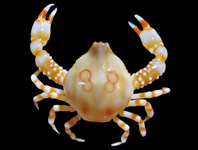Abstract
On the basis of molecular and morphological evidence, we evaluated the taxonomic identity of two species of Andean frogs of the genus Telmatobius: Telmatobius pefauri and T. zapahuirensis, present in the western Andean slopes at the northern extreme of Chile. We also investigated the taxonomic assignment of five populations of Telmatobius recently discovered around the type localities of these two species. The results indicate that T. pefauri inhabits, not only Murmuntani its type locality, but also the montane localities of Belén, Copaquilla, Lupica, Saxamar and Socoroma. Our study also shows that T. pefauri and T. zapahuirensis are the same taxon. Therefore, Telmatobius zapahuirensis Veloso, Sallaberry, Navarro, Iturra, Valencia, Penna & Díaz, 1982 would be a subjective junior synonym of Telmatobius pefauri Veloso & Trueb, 1976.
References
Aguilar, C. & Valencia, N. (2009) Relaciones filogenéticas entre telmatobiinidos (Anura, Ceratophryidae, Telmatobiinae) de los Andes centrales basado en la morfología de los estados larval y adulto. Revista Peruana de Biología, 16, 43–50.
https://doi.org/10.15381/rpb.v16i1.174Barrionuevo, J.S. (2017) Frogs at the summits: phylogeny of the Andean frogs of the genus Telmatobius (Anura, Telmatobiidae) based on phenotypic characters. Cladistics, 33, 41–68.
https://doi.org/10.1111/cla.12158
Catenazzi, A., Vargas-García, V. & Lehr, E. (2015) A new species of Telmatobius (Amphibia, Anura, Telmatobiidae) from the Pacific slopes of the Andes, Peru. ZooKeys, 480, 81–95.
https://doi.org/10.3897/zookeys.480.8578Cei, J.M. (1986) Speciation and adaptative radiation in Andean Telmatobius frogs. In: Vuilleumier, F. & Monasterio, M. (Eds.), High altitude tropical biogeography. Oxford University Press, New York, pp. 374–386.
Correa, C., Donoso, J.P. & Ortiz, J.C. (2016) Estado de conocimiento y conservación de los anfibios de Chile: una síntesis de los últimos 10 años de investigación. Gayana, 80, 103–124.
https://doi.org/10.4067/s0717-65382016000100011De la Riva, I., García-París, M. & Parra-Olea, G. (2010) Systematics of Bolivian frogs of the genus Telmatobius (Anura, Ceratophryidae) based on mtDNA sequences. Systematics and Biodiversity, 8, 49–61.
https://doi.org/10.1080/14772000903526454De la Riva, I. & Harvey, M.B. (2003) A new species of Telmatobius from Bolivia and a redescription of T. simonsi Parker, 1940 (Amphibia: Anura: Leptodactylidae). Herpetologica, 59, 127–142.
https://doi.org/10.1655/0018-0831(2003)059[0127:ansotf]2.0.co;2
Duellman, W.E. & Trueb, L. (1986) Biology of Amphibians. McGraw-Hill, New York, 670 pp.
Formas, J.R., Benavides, E. & Cuevas, C.C. (2003) A new species of Telmatobius (Anura: Leptodactylidae) from río Vilama, northern Chile, and the redescription of T. halli Noble. Herpetologica, 59, 253–270.
https://doi.org/10.1655/0018-0831(2003)059[0253:ansota]2.0.co;2
Formas, J.R., Cuevas, C.C. & Núñez, J.J. (2006) A new species of Telmatobius (Anura: Leptodactylidae) from Northern Chile. Herpetologica, 62, 173–183.
https://doi.org/10.1655/05-08.1
Frost, D.R. (2016) Amphibian Species of the World: an Online Reference. Version 6.0. Electronic Database. American Museum of Natural History, New York, USA. Available from: http://research.amnh.org/herpetology/amphibia/index.html (Accessed 1 November 2016)
Hall, T. (1999) Bioedit: A user-friendly biological sequence alignment editor and analysis program for windows 95/98/NT. Version 5.0.9. Nucleic Acids Symposium Series, 41, 95–98.
Hammer, Ø., Harper, D.A.T. & Ryan, P.D. (2001) PAST: Paleontological Statistics Software Package for Education and Data Analysis. Palaeontologia Electronica, 4, 1–9.
IUCN SSC Amphibian Specialist Group. (2015) Telmatobius pefauri. The IUCN Red List of Threatened Species, 2015, e.T21583A79809777.
https://doi.org/10.2305/IUCN.UK.2015-4.RLTS.T21583A79809777.Jowett, T. (1986) Preparation of nucleic acids. In: Roberts, D.B. (Eds.), Drosophila: A Practical Approach. IRL Press, Oxford, pp. 275–286.
Kumar, S., Stecher, G. & Tamura, K. (2016) MEGA7: Molecular Evolutionary Genetics Analysis version 7.0 for bigger datasets. Molecular Biology and Evolution, 33 (7), 1870–1874.
https://doi.org/10.1093/molbev/msw054Mitchell, M.A. (2009) Anesthetic Considerations for Amphibians. Journal of Exotic Pet Medicine, 18, 40–49.
https://doi.org/10.1053/j.jepm.2008.11.006Miller, M.A., Pfeiffer, W. & Schwartz, T. (2010) Creating the CIPRES Science Gateway for inference of large phylogenetic trees. In: Proceedings of the gateway computing environments workshop (GCE). New Orleans, LA, pp. 1–8.
https://doi.org/10.1109/GCE.2010.5676129Noble, G.K. (1938) A new species of frog of the genus Telmatobius from Chile. American Museum Novitates, 973, 1–3.
Núñez, H. & Gálvez, O. (2015) Catálogo de la colección herpetológica del Museo Nacional de Historia Natural y nomenclátor basado en la colección. Publicaciones ocasionales Museo Nacional de Historia Natural, 64, 1–203.
Ronquist, F. & Huelsenbeck, J.P. (2003) MrBayes 3: Bayesian phylogenetic inference under mixed models. Bioinformatics, 19, 1572–1574.
https://doi.org/10.1093/bioinformatics/btg180
Sáez, P.A., Fibla, P., Correa, C., Sallaberry, M., Salinas, H., Veloso, A., Mella, J., Iturra, P. & Méndez, M.A. (2014) A new endemic lineage of Andean frog genus Telmatobius (Anura, Telmatobiidae) from the western slope of the Central Andes. Zoological Journal of the Linnean Society, 171, 769–782.
https://doi.org/10.1111/zoj.12152Seimon, T.A., Seimon, A., Daszak, P., Halloy, S.R.P., Schloegel, L.M., Aguilar, C.A., Sowell, P., Hyatt, A.D., Konecky, B. & Simmons, J.E. (2007) Upward range extension of Andean anurans and chytridiomycosis to extreme elevations in response to tropical deglaciation. Global Change Biology, 13, 288–299.
https://doi.org/10.1111/j.1365-2486.2006.01278.xSinsch, U., Salas, A.W. & Canales, V. (1995) Reassessment of central Peruvian Telmatobiinae (genera Batrachophrynus and Telmatobius). I. Morphometry and classification. Alytes, 13, 14–44.
Sinsch, U. & Lehr, E. (2010) Geographical variation in the high Andean frog Telmatobius carrillae Morales, 1988 (Ceratophryidae, Telmatobiinae): size, skin texture, and coloration. Journal of Herpetology, 44, 495–505.
https://doi.org/10.1670/09-081.1Stamatakis, A. (2014) RAxML version 8: A tool for Phylogenetic Analysis and Post-Analysis of Large Phylogenies. Bioinformatics, 30, 1312−1313.
https://doi.org/10.1093/bioinformatics/btu033
Swofford, D.L. (2002) PAUP*: Phylogenetic Analysis using parsimony (* and other methods). Version 4. Sinauer, Sunderland, Massachusetts.
Veloso, A., Sallaberry, M., Navarro, J., Iturra, P., Valencia, J., Penna, M. & Díaz, N. (1982) Contribución sistemática al conocimiento de la herpetofauna del extremo norte de Chile. In: Veloso, A. & Bustos, E. (Eds.), La Vegetación y vertebrados ectotérmicos del transecto Arica-Lago Chungará. ROSTLAC, Montevideo, pp. 135–268.
Veloso, A. & Trueb, L. (1976) Description of a new species of Telmatobiine frog, Telmatobius (Amphibia:Leptodactylidae) from the Andes of northern Chile. Ocassional papers of the Museum of Natural History the University of Kansas, 62, 1–10.
Wiens, J.J. (1993) Systematics of the leptodactylid frog genus Telmatobius in the Andes of northern Peru. Occasional Papers of the Museum of Natural History, The University of Kansas, 162, 1–76.
Vellard, J. (1953) Estudios sobre batracios andinos. II. El grupo Marmoratus y formas afines. Memorias del Museo de Historia Natural “Javier Prado”, 2, 1–61.

